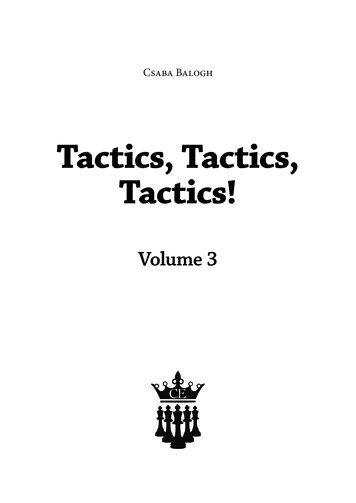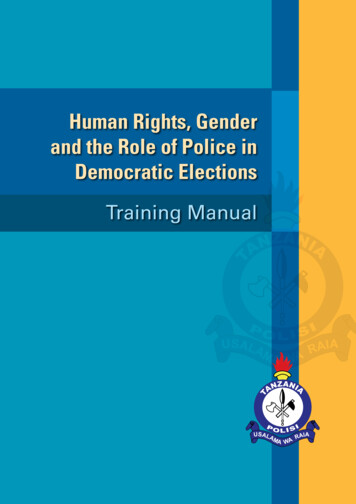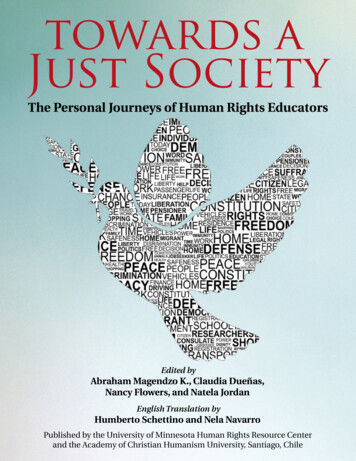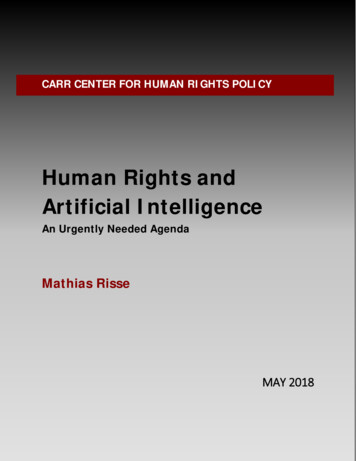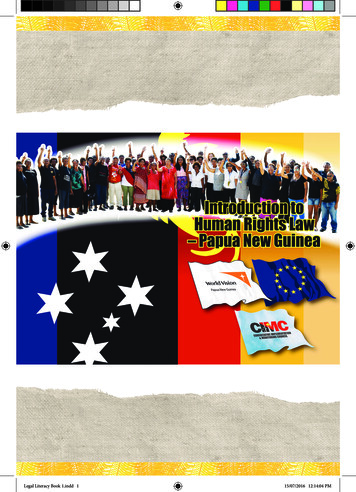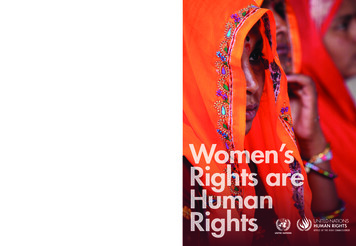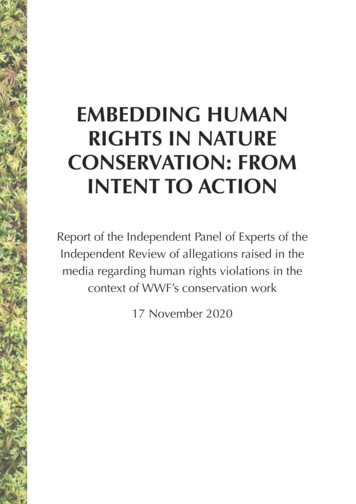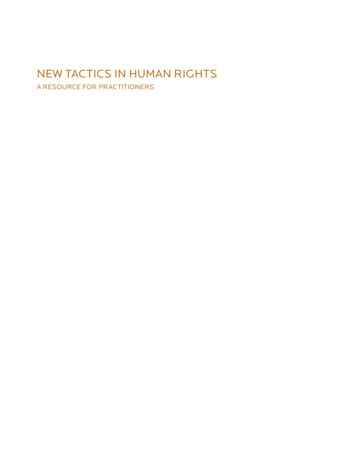
Transcription
NEW TACTICS IN HUMAN RIGHTSA RESOURCE FOR PRACTITIONERS
NEW TACTICS IN HUMAN RIGHTSA RESOURCE FOR PRACTITIONERSA workbook created byThe New Tactics in Human Rights ProjectA project ofThe Center for Victims of Torture
Printing: FriesensCopyright 2004 The Center for Victims of TortureWith this copyright, reproduction of this book for resale is strictly prohibited. However, we encourage groups to copyand distribute this document or portions of it free of charge, crediting the New Tactics in Human Rights Project andthe Center for Victims of Torture. Please contact us if you wish to translate this document or portions of it.28303442Prevention TacticsPhysical protectionSharing critical informationRemoving opportunities for abuse5052626876Intervention 96104Restorative TacticsRemembering abusesStrengthening individuals and communitiesSeeking redress116118126134144Building Human Rights Cultures and InstitutionsBuilding constituenciesCollaborationBuilding capacityBuilding awareness155156161162164166ResourcesDeveloping creative tactics and strategiesAdapting tacticsSharing your tactic: A sample tactic presentationSelf-care: Caring for your most valuable resourceFurther resourcesPrevention TacticsIntroduction, by Justice Richard J. GoldstoneAcknowledgementsThe Need for New Tactics, by Douglas A. JohnsonThe Workbook as a ResourceKey TermsAbout the New Tactics ProjectIntervention TacticsDesign: Matthew Rezac, MCAD DesignWorksType Design: Locator and Bryant, Eric Olson, Process Type FoundryPhotography: Dick Bancroft (except pages 26 and 153 by Ann Bancroft)81012192123Restorative TacticsWriting and Editing: Tricia Cornell, Kate Kelsch, Nicole PalaszCONTENTSBuilding Human RightsCultures and InstitutionsThe New Tactics in Human Rights ProjectA project of the Center for Victims of Torture717 East River RoadMinneapolis, MN 55455 1 612 436 4800www.cvt.orgwww.newtactics.orgIndexPrinted in Canada.ISBN: 0-9759789-0-X172 Index of Tactics190 Share a TacticResourcesThis book is also available for download free of charge at www.newtactics.org. Periodic updates will be made.
INTRODUCTIONIn the past two decades the world has seen the beginning of a newera for human rights, one in which the weight of international lawand international public opinion has come increasingly to bear. In the arena of international law, newmechanisms have transformed the way we think about and achieve justice. And at the same time, thecreative thinking and innovative spirit of individuals and organizations have changed the way we thinkabout what is possible in human rights — and therefore what we can achieve.Within the context of the International Criminal Tribunal for the former Yugoslavia, we used anothernew tactic: We made rape a war crime that could be prosecuted on its own, rather than as a secondaryoffense that was only appended to other offenses. When the tribunal indicted eight Bosnian Serb military officers on charges of systematic rape of Muslim women, it represented a sea change in the waythe world thought about gender-related crimes and human rights. This tactic has made it possible toachieve justice in many more cases since.All around the world and at all levels, in small villages and in national governments as well as at thehighest levels of international justice, people are creating and using innovative tactics to make theirwork more effective. The New Tactics in Human Rights Project captures these tactical innovations andshares them with others striving to advance human rights. I invite you to join me in celebrating thiswork and in making use of the valuable resource you now hold in your hands.Ten years ago legal experts would have laughed at the prospect of indicting and extraditing a powerfulformer dictator like Augusto Pinochet. This was not a tactic that seemed available to us. Perpetratorsat that level, no matter how barbarous their crimes, moved about the world with impunity. Pinochet’sarrest and extradition changed the way we think about what is possible in international justice. It addeda tactic to the human rights arsenal, one that is sure to be used again and again in the future.In reflecting on my own area of work, I have seen new opportunities for obtaining justice arise for victims of the gravest human rights abuses. The establishment of the International Criminal Tribunals forthe former Yugoslavia and Rwanda, which were the first war crimes courts to be created with the fullweight of international opinion behind them, opened new doors for justice. The international teamsworking on the tribunals, people from dozens of countries, were doing something that had never beenattempted before — making new law, setting new precedents, handing down indictments that did notlook like indictments that had ever been handed down before in any country. Together a new tacticwas created, one that paved the way for another, even more powerful tactic, the International Criminal Court. This court could now provide a tool to achieve justice no matter where or by whom crimesagainst humanity are perpetrated.I applaud efforts by human rights advocates to use national and international courts and other publicforums to call attention to crimes against humanity, wherever they occur, and to call loudly and boldlyfor justice. But these are just a few among the many new and innovative tactics being used by peoplearound the world, in spheres and regions as diverse as human experience itself, to promote and protect basic human dignity.I am proud to join the New Tactics in Human Rights Project in presenting this resource. While it couldnever claim to be an exhaustive catalogue, it is a rich compendium of this fresh and innovative thinking, one which we hope will be valuable to you in your work.— Justice Richard J. GoldstoneJustice of the Constitutional Court of South Africa, retiredChief Prosecutor of the UN International Criminal Tribunals for the former Yugoslavia and RwandaChairperson of the International Independent Inquiry on KosovoChairperson of the International Task Force on Terrorism established by the International Bar AssociationNew Tacticsin Human Rights8INTRODUCTIONJustice Richard J. Goldstonewww.newtactics.orgINTRODUCTIONJustice Richard J. Goldstonewww.newtactics.orgNew Tacticsin Human Rights9
ACKNOWLEDGEMENTSThis workbook would not have been possible without the assistance, advice and support of countlessindividuals and organizations around the world. We are grateful to the people and organizationsmentioned in this workbook for their initiatives and for the time they gave responding to our inquiries,informing us of their work and, in several cases, writing or editing pieces. We would also like to thankthose who recommended organizations to interview for consideration in the workbook.Kate Kelsch, project manager of the New Tactics in Human Rights Project, wrote and coordinatedearlier editions of the workbook, edited and oversaw the creation of this one and infected us all withher avid dedication to quality and accuracy. Tricia Cornell wrote and edited portions of the text. NicolePalasz wrote tactical summaries, researched tactics, coordinated research on tactics and was responsible for their selection and organization. Nancy Pearson developed the training resources. RachelTschida provided guidance and expertise. Susan Everson edited the text. Pam Arnold, Matthew Rezacand the staff at the Minneapolis College of Art and Design’s DesignWorks program patiently, skillfullyand enthusiastically shepherded the book from raw text to finish product. Douglas A. Johnson createdthe original vision and framework for the New Tactics project, without which this book would neverhave been possible.A number of generous donors provided financial support for creating the vision and content of theworkbook, including the John D. and Catherine T. MacArthur Foundation, the Paul & Phyllis FiremanCharitable Foundation, The Sigrid Rausing Trust (formerly known as the Ruben and Elisabeth RausingTrust), the United States Institute of Peace and donors who wish to remain anonymous. Other donorshave created a strong foundation for this book by supporting CVT’s involvement in other elements ofthe New Tactics project; these include the International Center on Nonviolent Conflict, the NationalPhilanthropic Trust, the Organization for Security and Cooperation in Europe, the Rockefeller Foundation and the foundation’s Bellagio Conference Center in Italy, and the United States Department ofState. CVT’s partners in the project have also received financial support from a number of organizations, making their participation possible.New Tacticsin Human Rights10ACKNOWLEDGEMENTSwww.newtactics.orgWe extend our appreciation to the New Tactics Advisory Committee and Working Group members(a full list of members is included on page 24) as well as other supporters who reviewed and commented on the workbook. Their experience with the realities of the struggle to advance human rights,and their understanding of what will be truly helpful to colleagues around the world, guided the development of the workbook and continue to guide the New Tactics project.Justice Richard A. Goldstone, Murat Belge, Morten Kjaerum, Sofia Macher, Kailash Satyarthi all contributed pieces that have enriched the content of the workbook.Others contributed their fine editorial and analytical skills in reviewing chapters, including SusanAtwood, Tanya Cromey, Phil Deering, Basil Fernando, Barbara Frey, Deanna Gallagher, Paul Haupt,Carine Kaneza, Salma Khan, Mark Ritchie, Liz Sevcenko and Bruce van Voorhis and his colleagues atthe Asian Human Rights Commission. Paul Dalton, Clarence Dias, Liam Mahony, Paul Milne, SuzanneMiric, Boris Pustintsev, Sir Nigel Rodley, Edson Spencer and Rajesh Tandon helped us shape thethinking behind the current format.The current edition was built on the strong foundation of two previous editions. Among the more than50 volunteers who helped research, write, edit and review those volumes we wish especially to thankAron Cramer, Bennett Freeman, Barbara Frey, Edward Halpin, Eileen Kaufman, Morten Kjaerum,John Salzberg, Robert Shoemake and David Weissbrodt. Phil Deering edited the second edition andDeanna Gallagher, Kenei Sato, Kathryn Weber and Wendy Weber wrote chapters.While we are grateful to all of these people and countless others for their talent, time, insight andgenerosity, we willingly acknowledge any oversights or errors that remain in the book as our own.Additionally, the opinions, findings and conclusions or recommendations expressed in this book arethose of the New Tactics project and do not necessarily reflect the views of our funders.ACKNOWLEDGEMENTSwww.newtactics.orgNew Tacticsin Human Rights11
THE NEED FOR NEW TACTICSBY DOUGLAS A. JOHNSONIndividually these stories are inspiring. Together, in the workbook that follows, they represent a visionof what can be accomplished in human rights.The modern human rights movementhas made enormous strides in the pastfew decades in the advancement of the human rights ideal and the establishment of specific protections. The movement created new international conventions condemning torture and protecting therights of women and children and developed an international consensus regarding the definition oflegitimate political activities that deserve protection and support. Political prisoners have been protected from harm and many have been freed. And in many nations, sophisticated institutions havebeen developed to promote adherence — on both domestic and foreign policy levels — to internationalhuman rights standards. We cannot overstate how important these accomplishments are or how difficult they were to achieve.The Limits of Curent StrategyThe persistence of torture represents a significant challenge to the global community. When the threemost common tactics of the human rights movement have not significantly reduced the incidenceof torture, it is time to take a good look at the limits of current strategy. Some sense of those limitsemerges from a process I call “tactical mapping.”Beginning with the relationship between the torturer and the victim, a group of ten experts on torture diagrammed other relationships in which that fundamental perversion is embedded and whichenable the torture to occur. For example, torturers are usually members of a team with strong hierarchical leadership; they may also be part of a particular police station or military unit. We followed theserelationships vertically to understand the chain of command that plans, organizes and funds the useof torture. But we also looked at each level horizontally, in order to understand other possible influences and relationships. Police stations, for instance, also have civilians and physicians in attendance;they, in turn, have relationships to the outside world that have some degree of control or influenceover them. The initial map developed using this process diagrammed over 400 relationships, from thehighly local to those in the international community.Three tactics, predominantly, led to these advancements: 1) setting international norms that createda body of conventions, treaties and standards; 2) monitoring compliance to these standards; and 3)denouncing or shaming government actions and inaction when the standards were violated. Over theyears, the infrastructure and skills these approaches demand have grown dramatically.It is clear that these tactics have brought about tremendous advances and thus should continue to besupported and pursued. It is equally clear that there are great limits to what we can accomplish in thisway and that these approaches are not, in and of themselves, enough to solve seemingly intractablehuman rights problems.Consider the problem of torture. There are, for example, more international conventions and standards, more constitutional protections and national legislation against torture than against any othersingle human rights abuse. There is more monitoring of torture, not only by the infrastructures oftreaty bodies, but by national and international nongovernmental organizations. Add to this capacitythe creation of over 250 treatment centers for torture survivors around the world, each of which bringsmedical resources to bear on documenting torture in thousands of victims and elevates the forensiccapacity to document torture. Torture is the most documented and denounced of all abuses.Yet when Amnesty International launched its third international campaign against torture in 2000, itconcluded that torture was as widespread then as it was when the organization launched its first globalcampaign in 1974.We posited that every relationship on the diagram was a possible place to begin an intervention tointerrupt or control the torturer/victim dyad. With the help of the diagram, we mapped the relationships targeted by various tactics and then the logical chain of relationships that they must influencein order to interrupt the dyad (hence the name, the “tactical map”).1 In doing so, we reached severalimportant conclusions:1Most tactics were initiated on the far edges of the diagram, such as on the international level, meaningthey had to work their way through many layers of other relationships before they indirectly affectedthe torturer/victim dyad. We speculated that this weakened or dissipated the force of the action.2Rather than brittle and easily disrupted, systems that use torture are often highly complex, allowingthe different institutions which benefit from torture’s use to support each other. As one part of the system is attacked, other parts (such as the police structure, the system of prosecutors, the indifferenceof the judiciary) help protect the target and allow it to self-repair. We understood this to mean that thesystem will not yield to individual tactics. Rather, the system needs to be affected in multiple areas atthe same time to create disequilibrium and prevent self-repair. This requires the use of multiple tacticsworking in conjunction as part of a more comprehensive strategy.3Most organizations in the field incorporate a limited number of tactics within their repertoire. Organizations tend to focus on a narrow set of tactics, and rarely cooperate or collaborate on them. Not onlydoes this limit influence to very narrow sectors in a complex, mutually reinforcing system, but each organization is shaping its strategy based on this isolated capacity rather than on what is needed to affectthe situation. We do what we can do, not what we need to do. We speculated that more coordinationbetween tactics would make them more effective.4So many relationships on the diagram were unaffected or uninvolved in any form of current action.Their strengths and concerns were not called forth to action. We speculated that a much wider array oftactics would be needed to engage these potential actors.In the past decade alone, we have witnessed human rights violations shocking in their scope — in Bosnia, Rwanda, Sierra Leone and the more than 150 countries that still perpetrate or allow torture. I muststate the obvious: something is not working.It is the contention of this workbook that advancing human rights requires the creation of a broaderhuman rights field, one that incorporates many more people and sectors of society than are currentlyengaged. It also requires the development of more comprehensive strategic approaches that can onlybe accomplished by using a far broader array of tactics than are currently in use.All over the world dedicated human rights practitioners have begun this work: developing innovativeapproaches, building unexpected strategic alliances and learning from unexpected sectors. The NewTactics in Human Rights Project aims to bring these innovators together and inspire others with theirwork. This workbook includes more than 75 stories of tactical innovation — by students, villagers, government commissioners and others who use sophisticated technology or the tools already at hand,and who work to achieve goals as seemingly diverse as fair elections, clean water and freedom forpolitical prisoners.New Tacticsin Human RightsTHE NEED FOR NEW TACTICSDouglas A. Johnson1Tactical mapping was developed with support from the Organization for Security and Cooperation in Europe’sTHE NEED FOR NEW TACTICSDouglas A. JohnsonNew Tacticsin Human Rights(OSCE) Advisory Panel for the Prevention of Torture and an in-kind donation from the Rockefeller Brothers Fund.12www.newtactics.orgwww.newtactics.org13
“I am not arguing, then, that tactical thinking or training supersedes strategic thinking,but rather that tactical development enriches strategic thought.”I believe these same conclusions hold true in other social and human rights issues. We need to findnew ways of working together — and new ways of working — in order to create effective strategies ofchange. Some current strategies require a macro-framework, in which the limited resources of manyare more effectively combined in a unified campaign. This might require what I call a “strategic convenor,” an institution or person with the moral credibility to pull us together in a new working relationship.But others can be initiated by organizations that begin to test new ways of pressuring complex systemsand stimulating action by new actors in the social web. This book is part of an overarching project,the New Tactics in Human Rights Project, to develop a dialogue within the human rights communityabout how that could come about and to broadly illustrate some of the tools at our disposal for moreeffective action.An Emerging IdeaThe Center for Victims of Torture (CVT) was founded in 1985 as the first comprehensive treatment facility for torture survivors in the United States. From the outset, CVT’s leadership conceived of its workas developing a new tactic of use to the human rights community. As we began to understand whattactics could emerge from our work, we also encouraged the development of other treatment programs for torture survivors. These new institutions created new strategic opportunities for the humanrights movement: restoring, for example, leadership stolen by repression, helping communities cometo terms with the legacy of fear, and organizing the health care community as a new human rights constituency. In the course of our work we also began to collect stories of other groups and people whowere innovating outside the mainstream’s focus.The New Tactics project was conceived in 1995. Shortly thereafter, CVT convened advisory groups inTurkey to explore the idea of a “best practices” symposium examining tactics used around the worldto resolve — or more effectively struggle with — widespread human rights abuses. We wanted to focuson solutions rather than problems and to proceed from the idea that, at least in part, abuses continuebecause both civil society and government are stymied by a lack of specific examples of what to do.Although we believed that a problem orientation was useful, it was already being done quite well bythe mainstream movement; we believed that not enough attention was focused on effective solutions.There was already a lot of attention to the “what” but too little attention on the “how.”The idea found resonance and respect with a broad sector of leaders in Turkey. In 1997, CVT formed apartnership with two Turkish organizations — Helsinki Citizens Assembly and the Human Rights Centre of the Turkish and Middle Eastern Institute for Public Administration — to develop the New Tacticsin Human Rights Project. Systematic research on innovative tactics began in earnest in 1999 with support from the John D. and Catherine T. MacArthur Foundation. We also established an InternationalAdvisory Committee of nine world leaders to provide visibility and political support and a HumanRights Working Group, composed of 21 human rights leaders in nearly every region of the world tohelp identify promising tactics and contribute to the project’s overall direction.The Working Group met with members of the Turkish advisory group in 2000 in Istanbul. The formerprime minister of Canada, the Right Honourable Kim Campbell, represented the International Advisory Committee and chaired the gathering. The group engaged in discussions on innovative approachesto advancing human rights, modeled cross-training approaches and formulated action plans for thefuture work of the project.New Tacticsin Human Rights14THE NEED FOR NEW TACTICSDouglas A. Johnsonwww.newtactics.orgIndividuals who have worked in the human rights field for much of their lives commented on howthe ideas and information shared at the meeting helped them think differently about opportunitiesto engage new people and approach matters from fresh perspectives. We have continued to build onthis initial vision by providing tools — including this book and a web page, www.newtactics.org — andby training human rights advocates in tactical innovation and strategic thinking through a series of regional cross-training workshops.Framework of Our ThinkingWorking at CVT over the past sixteen years has taught me that there are important social and politicalimplications in providing treatment to torture survivors. It has reshaped my thinking about the assumed distinctions between preventing torture and caring for survivors. CVT staff have discovered thatthe care of survivors is about recovering leadership and helping communities overcome the legacy offear. We’ve found that the metaphor of healing creates safer political space that allows communities togather, to work and to learn to take risks. Treatment centers like CVT bring new groups, such as educators, health care professionals and policy makers, into human rights work. And from our position as atreatment center we advocate for an end to torture and for policies and laws that will improve the livesof torture victims. Though we didn’t frame it as such, in the early years at least, we were broadening thedefinition of human rights work and implementing new tactics.Also framing my thoughts on New Tactics was my role in the international baby food campaign in the1970s and 1980s. In late 1976 I headed a grassroots activist group working on hunger issues; we hada program budget of 500 a year, plus my own subsistence salary. A small group of us began working together across the country and created the Infant Formula Action Coalition (INFACT). With thosemeager resources we launched a boycott against the world’s largest food corporation, Nestlé, to forcechanges in its marketing of breast milk substitutes. We built a network of 300 American chapters; created a coalition of over 120 national endorsing organizations with over 40 million members; createdthe first grassroots international boycott, operating in ten countries; formed the first transnationalissue network, IBFAN, operating in 67 nations; became one of the first NGOs invited as an equal participant with nations and corporations into a UN meeting and eventually negotiated the first and onlycorporate marketing code to emerge from the UN; and, after damaging Nestlé’s revenue by about 5 billion, signed a joint agreement with the company to change its marketing practices in alignmentwith the international code — an agreement that was hailed as “the most important victory in the history of the international consumer movement.”I am proud of that campaign and of nearly a decade of work. But, like all beginners, we made a fewmistakes. I can trace many of those mistakes to my limited knowledge of tactics. For example, I initiallyconfused tactics with strategy. Strategic thinking is really about how you make the best of what’s available to you and since, in my mind, I had only one tactic available to me, this was, perhaps, inevitable. Aswith so many leaders who emerge at the grassroots level trying to right a wrong, I began at the level ofan activity, graduated to thinking about tactics and struggled to understand how to shape strategy, withonly limited notions of the tools that were available to me.As I have had more experience in shaping the strategy of an organization, it has become clearer to methat the more we understand about tactics, the more flexibility we have to set new strategic directions.I am not arguing, then, that tactical thinking or training supersedes strategic thinking, but rather thattactical development enriches strategic thought.THE NEED FOR NEW TACTICSDouglas A. Johnsonwww.newtactics.orgNew Tacticsin Human Rights15
Goals, Strategy and TacticsWhile a focus on tactics is essential, it is not an organization’s first priority. An organization must firstset broad goals that reflect the values and beliefs of its founders, leaders or members and that incorporate its mission and purposes. These goals must be clear in order to focus planning. An organizationwill also need to establish intermediate goals that more closely state what it will accomplish over timeand that embed a strategic vision of what is feasible to accomplish.We must learn to tailor our tactics to our targets, finding those that will have the fullest possible impact. When tactics fail to affect our targets, we must innovate new and more effective tactics.3There is nothing mysterious about strategy, though it is often difficult to think strategically. Strategyis not a single decision, but rather a confluence of decisions: the selection of key objectives and appropriate targets, an understanding of needed constituencies and resources and decisions on whichtactics to use and when. More than two thousand years ago, Sun Tzu taught that strategy emerges fromunderstanding the adversary (its goals, strategy, strengths and weaknesses), understanding ourselves(our allies, what are our strengths and limits) and understanding the terrain (where a battle will befought). The adversary’s tactics are a key component to its strategy and knowledge of such tactics aidsus in counteracting them. What we can accomplish, including which tactics we know and which we cansuccessfully implement, will affect the formation of our strategy. Tactical thinking is therefore a criticalcomponent of strategic thinking.A tactic is a specific action that one takes within a strategy and a way to organize our resources to effectchange in the world. A tactic may be an activity, a system or even an institution in one situation and atechnique in another. Tactics will manifest themselves differently depending on the size, capabilityand resources of the organization. Tactics embody how one goes about making change, while a strategy involves decisions on which tactics to use, which targets deserve focus and which resources can beemployed. Our knowledge of tactics also shapes the strategy we choose.Some people find picketing in front of a torturer’s home a very frightening tactic; others find letterwriting too removed from where the change is needed. We can debate who is right or we can recognizethat people respond differently to a tactic based on their notions of causation, their tolerance for risk,the time they have available or their way of processing information.If the human rights community responds by offering only one or two tactics to engage the public, wewill appeal only to the narrow constituency to whom those tactics make sense. Legal tactics, for example, are notoriously difficult to use with wide sectors of the population: they tend to be long-term andesoteric efforts in which there is little for anyone beyond a small group of professionals to do. We needto employ other tactics that give more people the chance to be participants rather than observers.In cultures that have experienced repression, people have learned to withdraw from public life. Toengage constituencies in cultures such as these we need to offer tactics that appeal to different risktolerances and different views of social change.4What we know how to do influences what we think is possible to do;tactics help determine strategy.I don’t want to be overly det
the original vision and framework for the New Tactics project, without which this book would never have been possible. A number of generous donors provided financial support for creating the vision and content of the . workbook, including the John D. and Catherine T.

